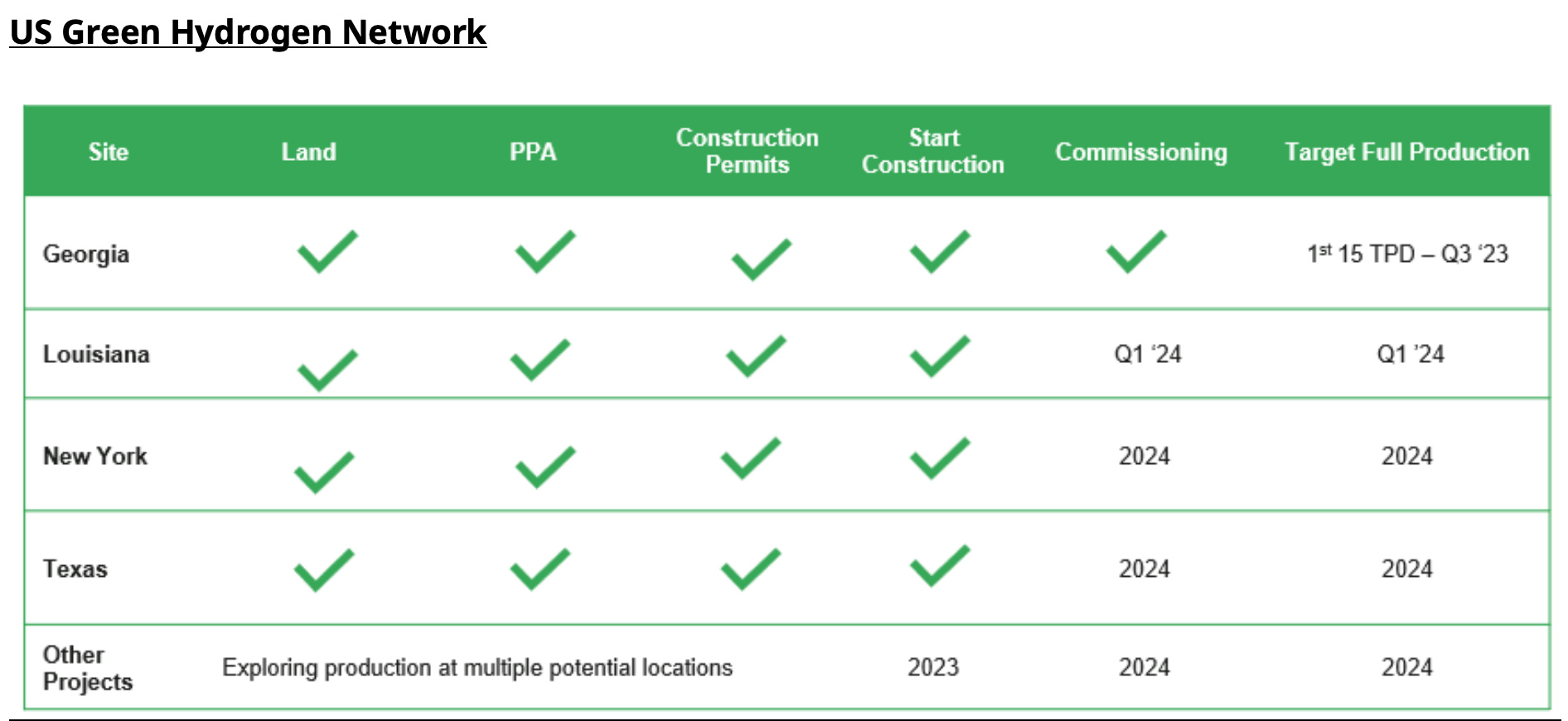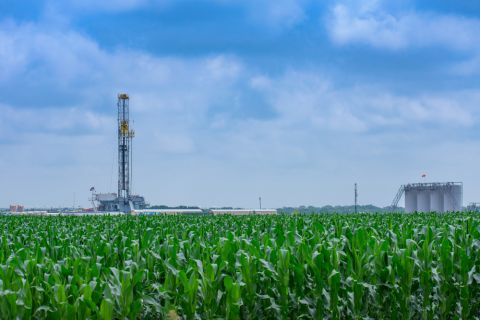
A Plug Power hydrogen storage and handling facility (Source: Plug Power)
With the clean hydrogen market poised to take off, Plug Power—known for its electrolyzers that split water into hydrogen—sees potential for about $5 billion in revenue over the next 12-18 months for its electrolyzer business alone.
The estimate, which is about $1 billion more than the company said in June, is based on hydrogen projects likely to reach final investment decisions.
“Some of them might not materialize; some of them move faster than expected, but that’s what the funnel sits at right now,” Sanjay Shrestha, chief strategy officer for Plug Power, told analysts Aug. 9 on the company’s second-quarter 2023 earnings call. Pointing out opportunities in the U.S., Europe and the Asia-Pacific region, he added, “We are certainly looking to close several more large electrolyzer deals here before the year is over.”
The company is tracking more than 7.5 gigawatts of electrolyzer sales opportunities, having already sealed orders in the second quarter with ReNu Energy Ltd., Ardagh Glass Limmared AB, APEX Group and major oil and gas companies.
The expected growth comes as government incentives encourage some energy players to seek out hydrogen as one option to decarbonize a fossil-fuel dependent society. Hydrogen’s flexibility and near-zero greenhouse-gas emissions make it one of the must-haves to hit net-zero targets. Hydrogen can be used for energy storage, for feedstock and as fuel. However, demand uncertainty and lack of ample offtake agreements are among today’s risks as developers look to move hydrogen—used mostly in petroleum refining and fertilizer production—to the next level.
Plug Power is tapping into the hydrogen market from multiple fronts with a vertical integration strategy, focused on delivering turnkey green hydrogen solutions. Its green hydrogen network includes fuel cells, electrolyzers, engineering services, liquefiers, and cryogenic storage and transportation.
Quarterly results
The New York-based company reported revenue of $260.2 million for second-quarter 2023, up 72% compared to a year earlier. The increase was driven by growth in material handling, cryogenics and liquefaction.
“Plug is in the process of developing an unparalleled hydrogen fuel cell platform. This encompasses our diverse array of products, extensive international collaborations, backing from government entities, financial partners and our robust infrastructure,” said Plug Power CEO Andy Marsh. “Our second-quarter outcome reveals noticeable growth in several of our recently launched products, particularly in our cryogenic sector, which garnered $69 million in revenue, making a more than threefold rise over the previous year.”
Results beat Wall Street expectations in some areas, while performance was less than optimal in others. Analysts’ views were mixed.
“With strategic acquisitions, partnerships, and joint ventures, Plug 1) continues to lead PEM fuel cell technology, 2) achieved full vertical integration in green hydrogen production, and 3) boasts a robust balance sheet. This well positions the company to leverage the rapid energy evolution and the supercharging hydrogen market,” James West, senior managing director for Evercore, said in a research note. “Every quarter introduces fresh strategic investments or collaborations … as the hydrogen economy takes shape and businesses increasingly adopt hydrogen to facilitate deep decarbonization.”
Tailwinds include hydrogen hubs and the Rochester Gigafactory expansion that will double its production capacity to 200 MW per month by year’s end, plus opportunities in areas such as BEV charging, green ammonia, steel and methanol, he added.
Headlining the earnings review as “a race between cash burn and capital infusion,” Piper Sandler summed up the results as “an unfavorable update.”
In a note, Piper Sandler analyst Kashy Harrison pointed out that while Plug’s revenues beat expectations, it had an EBITDA miss.
“PLUG believes most of these margin challenges will be resolved with scale and/or the green hydrogen facility ramp,” Harrison wrote, noting the operating loss and inventory builds, among other observations. “PLUG indicated that it expects inventory to represent less of a drag during 2H and also expects to raise $1.0-$1.5B of (non-equity) capital over the next 18 months. As such, PLUG is juggling scaling manufacturing operations to profitability, developing capital intensive hydrogen infrastructure, managing working capital, raising financing, and lobbying for optimal IRA guidance (September).”
Gross margin challenges were acknowledged by Plug executives.
Excluding one-time charges, second-quarter margins would have been minus 12%, a more than 20% improvement over the first quarter, Marsh said. “Throughout the rest of 2023, we will see continual margin expansion.”
Project updates, delays
Plug also acknowledged delays as the company works to bring online a slew of green hydrogen projects in Georgia, Louisiana, Texas and Tennessee. Plug said when these sites are operating at full capacity, the company expects its fuel business to turn positive.
“The NY plant, scheduled to commission in the middle to later part of 2024, will be another significant capacity and contribution inflection point,” Plug said.
Construction and commissioning activities are also underway in Louisiana, where Plug and partner Olin plan to start production in first-quarter 2024.
Having executed an engineering, procurement and construction (EPC) contract with Kiewit, Plug said the stage is set for one of the key financial considerations for its Texas hydrogen facility. The company is now targeting liquid production in second-half 2024, instead of second-quarter 2024. “It took about six to nine months instead of, probably, a typical three to six months” to negotiate the first-of-its-kind EPC contract, Shrestha said. “We felt like that extra three to six months is well worth it,” as the contract establishes a template and standard of how such projects should be executed.

In New York, “efforts to energize the substation are underway, aligning with our objective to achieve liquid production in the second half of 2024. Timing of substation energization will largely dictate timing of liquid production,” Plug said, noting collaboration with New York Power Authority and National Grid.
The liquid plant cannot go online until the substation is energized, Shrestha said, adding that is expected in third-quarter 2024. ‘We have procured all the long lead time items,” including the electrolyzer and liquefier.
In Georgia, commissioning activities are in the final stages and expectations are to reach 17.5 tons per day of production in third-quarter 2023. Currently, 2.5 tons per day of gaseous hydrogen is being produced and delivered to customers. The plant was previously expected to be producing liquid by now.
Gaseous hydrogen has been produced at the plant, and Shrestha said Plug is in the process of ramping up the liquefiers.
“We clearly recognize that we’ve been three to six months behind what we originally wanted it to be. But having said that, this plant is still coming online in 12 months since we actually issued the EPC contract,” Shrestha said, also pointing out the need for safety—including worker safety due to hot weather—with this first-of-a-kind integrated electrolyzer liquefier on-site storage site. “So, long story and a quick comment, we are going to be producing liquid here in the month of August.”
Recommended Reading
Gulfport Plans Liquids-rich Program After ‘Strong’ Ohio Oil Tests
2024-05-01 - Appalachia gas producer Gulfport Energy continues to report “strong oil production” from a two-well Hendershot pad drilled in eastern Ohio last year. Gulfport plans to develop additional liquids-rich opportunities this year as natural gas prices hover near record lows.
Chevron CEO: Permian, D-J Basin Production Fuels US Output Growth
2024-04-29 - Chevron continues to prioritize Permian Basin investment for new production and is seeing D-J Basin growth after closing its $6.3 billion acquisition of PDC Energy last year, CEO Mike Wirth said.
Novo II Reloads, Aims for Delaware Deals After $1.5B Exit Last Year
2024-04-24 - After Novo I sold its Delaware Basin position for $1.5 billion last year, Novo Oil & Gas II is reloading with EnCap backing and aiming for more Delaware deals.
Enverus: 1Q Upstream Deals Hit $51B, but Consolidation is Slowing
2024-04-23 - Oil and gas dealmaking continued at a high clip in the first quarter, especially in the Permian Basin. But a thinning list of potential takeout targets, and an invigorated Federal Trade Commission, are chilling the red-hot M&A market.





